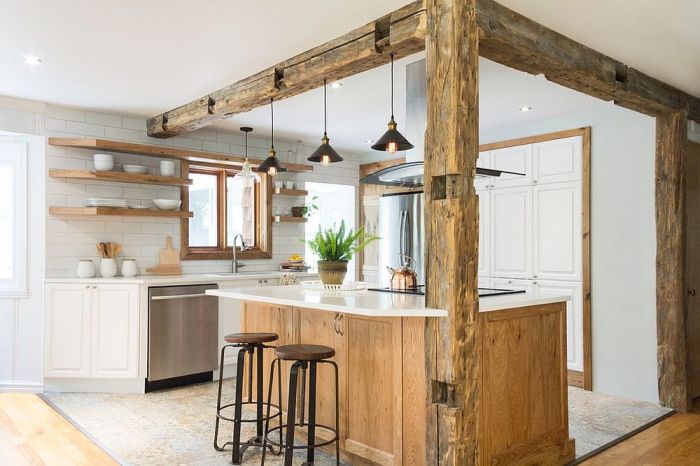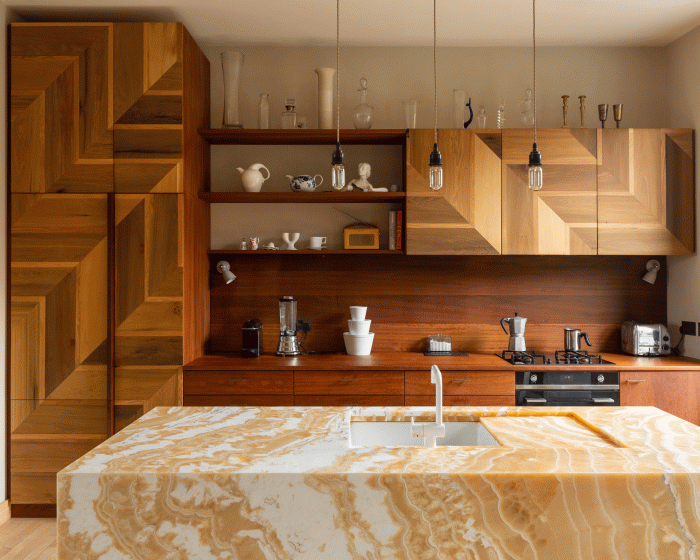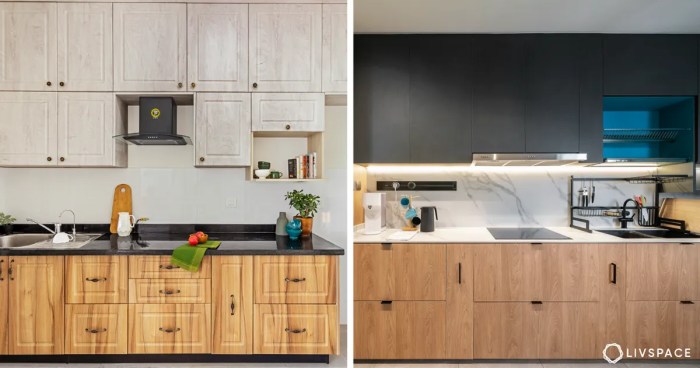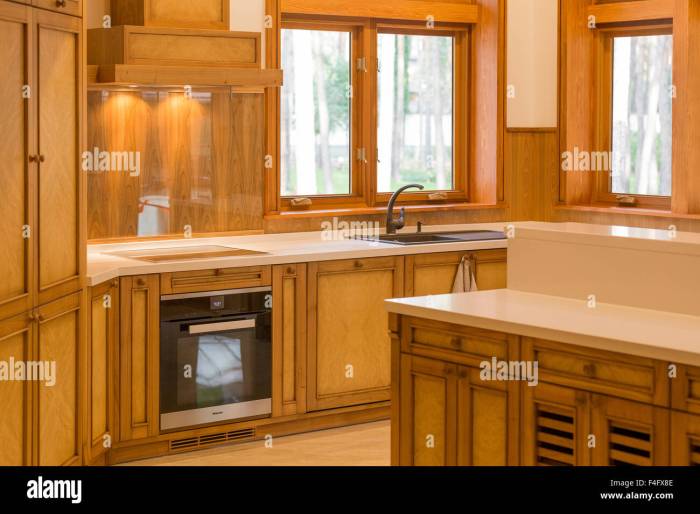The allure of a clean and cozy wooden kitchen lies in its inherent warmth and timeless appeal. It’s a space where the natural beauty of wood intertwines with thoughtful design, creating an environment that is both functional and aesthetically pleasing. This exploration delves into the science and art of crafting such a kitchen, from selecting the perfect wood type and finish to optimizing layout and incorporating cozy design elements.
We’ll examine the interplay of light and shadow, the impact of different materials, and the creation of a sensory-rich atmosphere that transforms a kitchen into a heart of the home.
We will investigate the practical considerations, such as durability and maintenance of various wood types in a high-use environment like a kitchen. The exploration will encompass efficient space planning, innovative storage solutions, and the integration of modern appliances without compromising the rustic charm. Ultimately, the goal is to provide a comprehensive guide for anyone dreaming of a clean, cozy, and functional wooden kitchen, irrespective of kitchen size or style preference.
Aesthetic Appeal of a Clean and Cozy Wooden Kitchen
The inherent warmth and natural beauty of wood create a uniquely inviting atmosphere in a kitchen, a space often considered the heart of the home. A clean and cozy wooden kitchen achieves this ambiance through a careful consideration of visual elements, lighting, and material choices, resulting in a space that is both functional and aesthetically pleasing. The interplay of light and shadow on the wood grain contributes significantly to the overall mood and character.
Visual Characteristics and Light Interaction
The visual appeal of a clean and cozy wooden kitchen stems from the interplay of light and shadow across the wood’s surface. The natural grain patterns, knots, and variations in color create a dynamic visual texture. Light, whether natural or artificial, interacts with this texture, highlighting certain features while casting shadows in others, adding depth and visual interest.
A well-placed window, for instance, can bathe the kitchen in soft, warm light, accentuating the wood’s grain and creating a sense of openness. Conversely, strategically placed recessed lighting can highlight specific areas like countertops or a central island, while softer ambient lighting creates a more intimate and relaxing feel. The contrast between light and shadow enhances the three-dimensionality of the wood, bringing out its natural beauty.
Lighting Design for Cozy Ambiance
Natural light is paramount in achieving a cozy atmosphere. Large windows, skylights, or even strategically placed glass doors can flood the kitchen with sunlight, enhancing the warmth of the wood and creating a bright, airy feel. However, natural light alone is often insufficient for evening use or during darker days. Therefore, a layered lighting approach is crucial.
This includes ambient lighting (general illumination), task lighting (for work areas like countertops and sinks), and accent lighting (to highlight features like artwork or open shelving). Warm-toned LED lights, for example, mimic the warmth of natural light and complement the wood’s tones effectively, avoiding harsh, cool-toned lighting which can feel sterile and uninviting. Dimmer switches allow for adjusting the light intensity to suit the mood and time of day, further enhancing the cozy atmosphere.
Mood Board: Color Palette and Textures
A clean and cozy wooden kitchen typically employs a color palette centered around warm, natural tones. Imagine a mood board featuring:* Base Colors: Creamy whites or soft off-whites for walls and cabinetry, complementing the wood tones without overwhelming them.
Accent Colors
Muted greens, blues, or grays, echoing natural landscapes and creating a sense of calm. These colors might be incorporated through textiles, such as curtains or rugs, or through smaller decorative elements.
Wood Tones
Various shades of wood, from light blonde to rich walnut, creating visual interest and depth. The choice of wood tone significantly impacts the overall feel; lighter tones tend to feel more airy and bright, while darker tones create a more rustic and intimate atmosphere.
Textures
The inherent texture of the wood itself is a key element, but this can be further enhanced by incorporating other natural textures like linen curtains, cotton towels, and woven rugs. These elements add tactile comfort and visual warmth.
Comparison of Wood Types for Kitchens
The choice of wood significantly influences the aesthetic and practicality of a kitchen. Different wood types offer unique visual characteristics and varying levels of durability and maintenance requirements.
| Wood Type | Aesthetic Qualities | Practicality | Maintenance |
|---|---|---|---|
| Oak | Strong grain, durable, classic look, available in various tones | High durability, resists scratches and dents | Regular oiling or sealing recommended |
| Maple | Smooth, fine grain, light color, contemporary feel | Durable, but can be prone to scratches | Regular cleaning and occasional sealing |
| Cherry | Rich reddish-brown tones, deep grain, elegant appearance | Durable, but can be more expensive | Regular oiling or sealing recommended |
| Walnut | Dark brown tones, dramatic grain, luxurious feel | Durable, but can be more expensive | Regular oiling or sealing recommended |
Functionality and Design Elements
The functionality of a clean and cozy wooden kitchen hinges on the efficient integration of workflow, storage, and modern appliances within the rustic aesthetic. A well-designed wooden kitchen prioritizes ease of movement between key work areas – preparation, cooking, and cleaning – minimizing unnecessary steps and maximizing efficiency. Strategic placement of cabinetry and appliances contributes significantly to this seamless workflow.
Efficient layout is paramount in achieving both functionality and coziness. The principles of the kitchen work triangle – a conceptual layout connecting the sink, stove, and refrigerator – should be adapted to the specific space. This triangle, ideally forming an equilateral or isosceles triangle, minimizes wasted steps and promotes a smoother cooking experience. For example, placing the refrigerator near the preparation area minimizes travel distance when retrieving ingredients.
Similarly, locating the sink adjacent to the cooking area facilitates easy cleanup. The size and shape of the kitchen, along with the number of occupants, dictate the optimal arrangement of these elements.
Space-Saving Design Techniques for Small Wooden Kitchens
Small wooden kitchens often present unique design challenges. However, clever planning can maximize space and functionality. Utilizing vertical space is crucial; tall, narrow cabinets can hold significantly more than shorter, wider ones. Consider installing pull-out shelves and drawers for easy access to items stored at the back of deep cabinets. Multifunctional furniture, such as kitchen islands with built-in storage or seating, can serve multiple purposes while saving space.
Custom-built cabinetry, designed to precisely fit the available space, eliminates wasted corners and awkward gaps. For instance, a custom-built corner cabinet with a carousel system allows for easy access to items stored in even the most inaccessible corners. Another example is using slimline appliances, which are specifically designed to occupy less space without sacrificing functionality.
Integration of Modern Appliances in a Rustic Setting
Integrating modern appliances into a rustic wooden kitchen requires careful consideration of aesthetics. Stainless steel appliances, while highly functional, can clash with the warm tones of wood. However, several solutions exist to maintain harmony. Appliances with matte black or brushed nickel finishes offer a more subtle, less jarring contrast against wood. Alternatively, consider custom-made cabinetry panels to seamlessly integrate appliances into the overall design, effectively concealing them.
For example, a custom-made wooden panel can be fitted over a refrigerator, preserving the rustic aesthetic while still allowing for easy access. This approach ensures that modern functionality doesn’t compromise the visual integrity of the wooden theme.
Innovative Storage Solutions for Wooden Kitchens
Effective storage is vital in any kitchen, particularly in a wooden one where the visual appeal of open shelving might be desired.
The following innovative storage solutions specifically cater to the needs and aesthetic of a wooden kitchen:
- Pull-out pantry systems: These maximize storage space in narrow cabinets, offering easy access to all items. They are especially effective in utilizing vertical space efficiently.
- Under-cabinet organizers: These maximize space beneath cabinets, keeping frequently used items readily available while keeping the countertop clutter-free. They often feature customizable dividers to accommodate various sized items.
- Corner cabinet solutions: Carousel or “lazy Susan” systems provide easy access to items stored in awkward corner cabinets, preventing items from getting lost at the back.
- Wall-mounted pot racks: These display cookware while freeing up valuable cabinet space, adding to the kitchen’s rustic charm. They can be crafted from wood to match the overall design.
- Built-in spice racks: These are typically integrated into cabinetry, providing easy access to spices while keeping them organized and visually appealing.
Materials and Finishes

The choice of wood and its finish significantly impacts a wooden kitchen’s aesthetic appeal, durability, and maintenance requirements. Understanding the properties of different wood types and finishes is crucial for creating a kitchen that is both beautiful and functional, capable of withstanding the rigors of daily use. This section explores the various materials and finishes, highlighting their advantages and disadvantages within the demanding kitchen environment.
Wood Finishes: A Comparative Analysis
Wood finishes serve a dual purpose: protecting the wood from moisture, scratches, and stains, and enhancing its natural beauty. Three common finishes are varnish, stain, and oil. Varnish forms a hard, protective layer that is highly resistant to water and abrasion. It offers excellent durability but can mask the wood’s natural grain. Stains, conversely, penetrate the wood, enhancing its color and grain pattern while offering less protection than varnish.
Oil finishes, such as tung oil or linseed oil, soak into the wood, providing a subtle sheen and enhancing its natural beauty. They offer good protection against minor scratches but require more frequent maintenance than varnish. The choice depends on the desired level of protection and aesthetic outcome. For high-traffic areas like kitchen countertops, a durable varnish might be preferred, whereas a more rustic look might benefit from an oil finish on less exposed surfaces.
Wood Types and Maintenance Procedures
Different wood types exhibit varying levels of hardness, porosity, and resistance to moisture. Hardwoods like oak and maple are denser and more resistant to scratches and dents compared to softer woods such as pine or cherry. Maintenance procedures vary accordingly. Hardwoods often require less frequent cleaning and maintenance than softer woods, which are more prone to scratches and dents.
Regular dusting is crucial for all wood types. For cleaning, a damp (not wet) cloth is recommended. Avoid harsh chemicals and abrasive cleaners. Oil-finished wood may require occasional re-oiling to maintain its protective layer and sheen. Varnished surfaces are more resistant to staining and can be cleaned with a mild soap solution.
Challenges of Using Wood in Kitchens
Kitchens present a challenging environment for wood due to the constant presence of moisture, heat, and potential impacts. Water damage is a significant concern. Prolonged exposure to water can cause wood to swell, warp, or even rot. This is particularly problematic in areas prone to spills or splashes, such as near sinks and stoves. Scratches are another common issue, especially on countertops and table surfaces.
The choice of wood type and finish plays a crucial role in mitigating these challenges. Hardwoods with a durable finish offer better resistance to damage. Regular maintenance, including prompt cleaning of spills and the use of protective mats, is also essential.
Complementary Materials in Wooden Kitchens
Integrating complementary materials with wood enhances both functionality and aesthetics. Stone, particularly granite or quartz, is a popular choice for countertops due to its durability and resistance to heat and stains. The combination of warm wood and cool stone creates a visually appealing contrast. Metals, such as stainless steel or brushed nickel, are frequently used for appliances, hardware, and fixtures.
These materials complement wood by providing a modern touch and a sense of durability. The use of these materials can balance the organic feel of wood with the clean lines of modern design, creating a harmonious and functional kitchen space.
Creating a Cozy Atmosphere

Transforming a clean and functional wooden kitchen into a truly inviting space involves understanding the psychology of comfort and leveraging design principles to create a warm and welcoming atmosphere. The strategic use of textiles, lighting, and carefully chosen décor elements plays a crucial role in achieving this cozy ambiance.
Textile Contributions to Coziness
Textiles introduce a crucial element of tactile comfort and visual warmth to a wooden kitchen. The inherent hardness of wood is softened by the introduction of plush fabrics. Curtains, for example, not only filter sunlight, controlling brightness and preventing glare, but also add a layer of softness to the overall aesthetic. Their drape and texture contribute to a sense of enclosure and intimacy.
Similarly, rugs placed underfoot provide warmth and comfort, mitigating the cold hardness of a wooden floor. The choice of material—a thick wool rug, for instance, versus a thin cotton mat—directly impacts the level of perceived warmth. Finally, soft, absorbent towels hung strategically add visual texture and a comforting sense of preparedness, subtly signaling a space dedicated to care and nurturing.
The color and pattern of textiles should complement the overall wooden aesthetic, perhaps echoing the wood grain or introducing complementary tones.
Lighting for Warmth and Intimacy
Lighting significantly impacts the perceived warmth and intimacy of a space. The ideal lighting scheme for a cozy wooden kitchen blends ambient, task, and accent lighting. Ambient lighting, such as recessed lighting or a central pendant light, provides overall illumination. However, to enhance coziness, consider incorporating warm-toned LED bulbs (around 2700K color temperature) to mimic the warmth of incandescent light.
Task lighting, such as under-cabinet lights or a pendant light above the island, ensures sufficient illumination for food preparation. Accent lighting, using strategically placed spotlights or fairy lights, highlights specific features, such as artwork or plants, creating visual interest and a sense of depth. Dimmers allow for adjustable brightness, adapting the lighting to the time of day and mood, further enhancing the cozy feel.
Avoiding harsh overhead lighting is key; instead, prioritize softer, diffused light sources.
Decor Elements Complementing the Aesthetic
The careful selection of decorative elements can significantly enhance the cozy atmosphere of a clean and wooden kitchen.
- Plants: Houseplants introduce life and vibrancy, softening hard lines and adding a natural touch. Consider herbs in pots near the cooking area, or larger plants in corners to add visual interest. The green hues of plants complement the warm tones of wood, creating a balanced and harmonious aesthetic.
- Artwork: Artwork adds personality and visual appeal. Choose pieces with warm colors and textures that complement the wooden aesthetic. A rustic-style painting or a collection of framed botanical prints can contribute to a cozy atmosphere.
- Kitchenware: Displaying some carefully chosen kitchenware can add visual interest and a sense of warmth. Consider open shelving to display attractive ceramic bowls, wooden utensils, or copper pots. Avoid overcrowding; strategic placement enhances the aesthetic rather than detracting from it.
Ideal Ambiance: Sensory Details
The ideal ambiance in a clean and cozy wooden kitchen is a multi-sensory experience. The scent of freshly baked bread or simmering spices fills the air, mingling subtly with the natural aroma of the wood itself. Soft, natural sounds—perhaps the gentle hum of a refrigerator, the quiet clinking of cutlery, or the soft patter of rain against the window—create a calming backdrop.
The visual experience is one of warmth and inviting textures, the interplay of natural light filtering through soft curtains and the warm glow of carefully chosen lighting enhancing the beauty of the wooden surfaces and decorative elements. The tactile experience is equally important; the smooth, cool surface of the wooden countertops contrasts pleasingly with the soft textures of the textiles, creating a welcoming and comfortable space.
Illustrative Examples

The following examples showcase the versatility of clean and cozy wooden kitchens, demonstrating how different design styles can achieve this aesthetic while maintaining functionality. Each style utilizes wood in unique ways, reflecting diverse cultural influences and design philosophies. The choice of wood type, color palette, and design elements significantly impact the overall atmosphere and feel of the space.
Rustic Wooden Kitchen
The rustic style emphasizes natural materials and a sense of aged charm. This style often utilizes reclaimed wood, highlighting its natural imperfections and unique character.
- Wood Type: Reclaimed barn wood, aged oak, or pine, showcasing knots, cracks, and variations in color. The inherent imperfections of reclaimed wood add to its rustic appeal, reflecting a history embedded in the material itself. Scientifically, the aging process alters the wood’s chemical composition, leading to the development of unique textures and colors.
- Color Palette: Warm, earthy tones such as browns, creams, and muted greens. These colors complement the natural tones of the wood, creating a calming and inviting atmosphere. The psychology of color suggests that these earth tones promote feelings of security and comfort.
- Key Design Elements: Open shelving, exposed beams, antique or vintage hardware, and a large farmhouse sink. These elements contribute to the overall rustic aesthetic, emphasizing a connection to nature and traditional craftsmanship.
Modern Farmhouse Wooden Kitchen
This style blends rustic charm with modern functionality and clean lines. It maintains the warmth of wood while incorporating contemporary design elements.
- Wood Type: White oak or maple, often treated for a smoother, more refined finish. While still utilizing wood’s natural beauty, the modern farmhouse style prefers a cleaner aesthetic compared to the rustic approach. The choice of oak or maple reflects a preference for hardwoods known for their durability and resistance to wear.
- Color Palette: A mix of whites, creams, and light grays, complemented by warmer wood tones. This balance creates a bright and airy space while retaining the warmth associated with wood. The use of lighter colors enhances the sense of spaciousness, a key element in modern design.
- Key Design Elements: Shaker-style cabinetry, integrated appliances, a large island with seating, and pendant lighting. These elements combine modern conveniences with the rustic charm of wood, creating a balanced and sophisticated aesthetic.
Scandinavian Wooden Kitchen
The Scandinavian style emphasizes minimalism, functionality, and natural light. Wood plays a crucial role in creating a warm and inviting atmosphere within a clean and uncluttered space.
- Wood Type: Light-colored woods like birch or pine, often left with a natural or lightly stained finish. The light color enhances the brightness of the space, reflecting light and creating a feeling of openness. Birch, in particular, is known for its smooth texture and light color, fitting seamlessly within the Scandinavian minimalist aesthetic.
- Color Palette: Whites, grays, and light blues, complemented by the natural tones of the wood. This palette emphasizes cleanliness and simplicity, creating a serene and calming environment. The psychological impact of these colors is known to promote feelings of calm and tranquility.
- Key Design Elements: Simple cabinetry, open shelving, integrated appliances, and natural light. The focus is on functionality and clean lines, with wood used as an accent rather than a dominant feature. This approach prioritizes a clutter-free environment, a central tenet of Scandinavian design philosophy.
A Clean and Cozy Wooden Kitchen: A Detailed Description
Imagine stepping into a kitchen bathed in the soft glow of morning sunlight, filtering through a large window overlooking a verdant garden. The air is filled with the subtle scent of freshly brewed coffee and the warmth of light-colored oak cabinetry, its smooth surface gleaming softly under the light. The countertops, crafted from a creamy-white marble, provide a striking contrast to the warm wood, reflecting the light and creating a sense of spaciousness.
A large farmhouse sink, made of durable fireclay, sits nestled beneath a window, offering a picturesque view while completing the tasks at hand. Open shelving displays a curated collection of ceramic dishes and vintage glass jars, adding a touch of personality without cluttering the space. The floor, composed of wide, light-colored oak planks, feels comfortably warm underfoot, inviting you to linger.
A single, elegantly designed pendant light hangs above the kitchen island, casting a gentle, focused light on the space. The overall feeling is one of serenity and warmth, a space where functionality seamlessly blends with a sense of calm and inviting coziness. The gentle creak of the wooden drawers and the soft hum of the refrigerator are the only sounds that break the quiet tranquility.
Closing Summary

Designing a clean and cozy wooden kitchen is a journey of balancing aesthetics and functionality. By carefully considering the interplay of wood types, finishes, lighting, and design elements, one can create a space that is both visually stunning and deeply inviting. The key lies in understanding the properties of wood, the principles of efficient kitchen design, and the art of creating a warm and welcoming atmosphere.
From the careful selection of wood finishes that enhance durability to the strategic placement of lighting that accentuates the space’s natural beauty, every detail contributes to the overall experience. The result is a kitchen that is not merely a place to prepare food, but a sanctuary of warmth, comfort, and style.
FAQ Explained
What are the best wood sealants for a kitchen?
The optimal sealant depends on the wood type and desired aesthetic. Polyurethane offers excellent water resistance, while oil-based finishes enhance the wood’s natural beauty but require more frequent maintenance. Water-based sealants are low-VOC and easier to clean up.
How do I prevent water damage in a wooden kitchen?
Promptly wipe up spills, use coasters and trivets under hot dishes, and ensure adequate ventilation to prevent moisture buildup. Consider using sealant with high water resistance and regularly inspect for any signs of damage.
Can I use reclaimed wood in my kitchen?
Yes, reclaimed wood adds unique character but requires careful inspection for pests and structural soundness. Ensure it’s properly treated and sealed for kitchen use.
How often should I clean my wooden countertops?
Daily wiping with a damp cloth is sufficient. For deeper cleaning, use a mild detergent and avoid abrasive cleaners. Regular oiling (for oiled finishes) helps maintain the wood’s condition.
